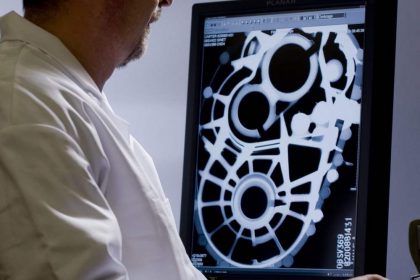
The ANR project FOEHN (2017-2020) is part of the research carried out to increase the reliability of NDT (Non-Destructive Testing) methods used in industry. Although the technical reliability of NDT processes has been the subject of numerous reinforcements, organizational and human factors (OHF) remain insufficiently considered by the NDT community.
Initially, the project was based on a case study analysis of gaps in NDT performance related to organizational and human aspects of the activity. This first phase resulted in exchanges between the Centre de recherches sur les Risques & les Crises (CRC, MINES ParisTech, PSL) and experts in high-energy Radiographic Testing (RT) from the Divison Industrielle (DI) of EDF and the French Institut de Soudures (IS). One of the selected case studies showed that several successive inspections of an installation did not allow the detection of an existing defect before it was the cause of a leak in a nuclear power plant. This case led to focus the OHF analysis on the radiogram interpretation phase (when, like a doctor inspecting a radio in search of a fracture, the interpreter seeks to identify possible defects in a welded part or assembly).
The task of analyzing and modeling the OHFs was based on a bibliographical study, supplemented by a campaign of non-participatory observations of operators on site and semi-directive interviews and the follow-up of training of operators in NDT. Thus, it was possible to carry out: (1) a sociology of the profession, highlighting in particular the main factors of attractiveness and constraints of the profession; (2) a modelling of the activity and human performance determinants for the purpose of quantitative estimation of probability of error.
By adapting the CREAM method (Hollnagel, 1998), the probability of failure for a given interpretation activity is obtained by means of a hierarchical task analysis (HTA) and a list of contextual influencing factors (CPC for Common Performance Conditions). By applying the methodological principles of Hollnagel, it is then possible to estimate, for a given interpretation situation, the phase of the activity with the greatest risk of human error.
At the end of this work, it is advisable to confirm the interest of considering organizational and human factors in the reflections on the reliability of NDT processes. The degree of “cultural maturity” of the sector has been assessed in different ways according to the actors and/or organizations studied. Although in different forms, a common concern exists for the relations, interactions, exchanges between people and structures. The observation campaigns and interviews carried out within the framework of the project highlight work sites referring to the fields of ergonomics, psychology, sociology but also anthropology (such as the question of safety culture in relation to the feeling of belonging to a body, a professional group and its values, rites, myths) or even philosophy (since there is a controller’s deontological charter).
Faced with such a vast field, it was necessary to reduce the scope of the study in order to be able to carry out a study with the desired granularity (the very fine granularity that allows a quantitative expression of the performance of an individual in the surrounding area!) The hope is twofold. Firstly, by adapting a proven HRA method to the NDT context, in the form of a “proof of concept”, it is to see this approach become more generalized, thus formalizing more knowledge about the profession. Then, by adapting the tools of the method to the reality of the controller’s “job”, it is to offer a support (and a raw material) to put into discussion, at different levels (intra- and inter-organizational), the question of human reliability without making people feel guilty. Because, as James Reason, Erik Hollnagel, Sidney Dekker and others have shown, improving safety requires the establishment of a just culture: a culture that recognizes the difference and clearly establishes the boundary between error and fault, between individual and systemic approaches to “human performance”.
It is to be hoped that this work will be relayed to the institutions of the profession (a COFREND working group on HFOs should start at the end of this project) so that it will ultimately contribute to producing the beneficial effects that Desmorat has observed in the field: “The analysis grid and the [CPCs] have made it possible to promote […] by focusing on identifying the causes of accidents, and not only the actions of the operators. The choice to integrate the [CPC] paradigm into safety management has had consequences outside the framework of accident analysis. One of the areas concerned has been the training of local managers.” (Desmorat, 2012).
Picture : Processes at the heart of the reliability and safety of critical systems.




